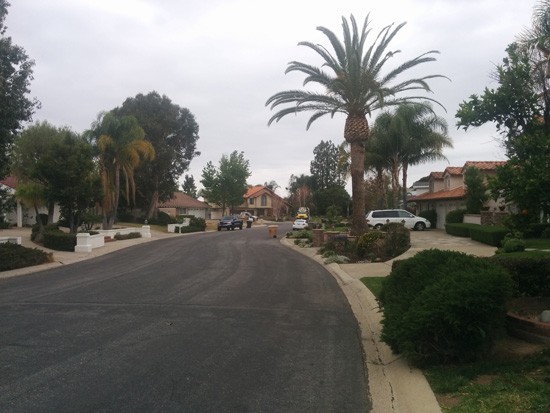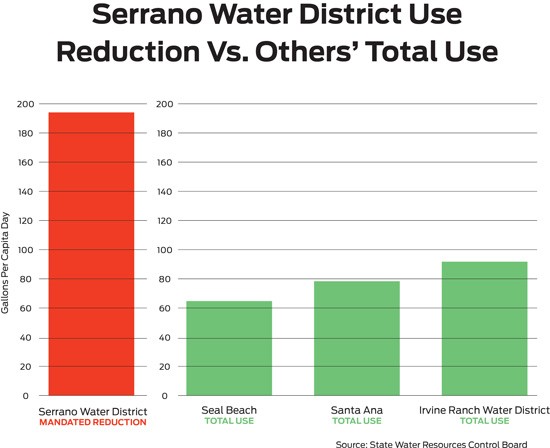
Driving into the suburban Orange County enclave of Villa Park, you'll pass medians and driveways lined with tall trees, their leaves green from the Southern California sun. You may notice Santiago Creek, which was dammed in the 1920s and is typically dry. If you do see water, it's more likely to be the Orange County Water District's Santiago Creek Recharge Basin, a manmade pond full of water percolating into the aquifer below.
Take a tour of the small, 5,900-person population city, and there will be sprawling lots, most of which are at least 20,000 square feet (nearly half an acre) in size, as legislated by city code. The houses are also grand, but they may seem small in comparison to all the land; the maximum house size is legislated to be approximately 30 percent of its lot in Villa Park. The remaining 70 percent? Landscaping. Grass and fruit trees and shrubbery that, while unbearably thirsty, have stayed mostly green into this fourth year of the drought.
]
And that's what has made Villa Park's Serrano Water District the fourth thirstiest water authority in all of California when measured per capita, and it's that water use that's bringing the drought to Villa Park. Last week, the State Water Resources Control Board released a draft of its rules designed to meet Governor Jerry Brown's mandated 25 percent cut in water use. The rules include reduction goals for each water authority in the state, ranging from 8 percent to 36 percent, depending on per capita usage. This summer, Villa Park would be one of four authorities in Orange County to face the toughest reduction requirement, a full 36 percent down from its usage in 2014, totaling just more than 190 gallons per person per day.
For comparison, people in the city of Seal Beach use 64.7 gallons per day, and Santa Ana 78.3. The total amount of water a person in Villa Park would have to save is more than the amount of water a person in Seal Beach and a person in Santa Ana would use combined.

If you look hard enough, the early effects of the drought can already be seen. The trees on the street medians are no longer surrounded by flowers or green grass, as they've historically been, but rather by dirt or brown turf, as the city can no longer water the medians using potable water. Some homeowners have even started ripping out excess grass. According to the Metropolitan Water District of Orange County, 17 households in Villa Park have taken advantage of its Turf Removal Program, which offers a rebate for each square foot of grass replaced with drought-tolerant landscaping. Together, those 17 households have ripped out more than 42,000 square feet of grass, representing a savings of nearly 1 million gallons of water per year.
“I've noticed a lot more brown patches and a lot more people pulling out their yards,” says Lori Churney, a Villa Park homeowner whose husband replaced their front yard with desert landscaping three years ago, before the drought entered its heyday. They replaced their yard not because of water, but because her husband was tired of mowing the hilly lawn. They reaped the benefits as rain failed to fall for the next few years. “We were lucky,” she says. “It's ended up bringing the water bill down a bit.”
Directly across the street, her neighbor, a doctor, had just ripped out nearly all of the greenery on one of his steep hillsides, temporarily leaving bare dirt covering half of the skeleton of an old sprinkler system. In other parts of the city, a few households have even replaced their lawns with artificial turf, but they're still far in the minority.
There's much more water to be saved, especially during the summer months, when 80 percent to 90 percent of water used is on outdoor landscaping, estimates Jerry Vilander, Serrano Water District's general manager. On April 14, Serrano's board of directors passed level-two water-shortage regulations to help ensure the district avoids state penalties of $10,000 per day. Included in the regulations are restrictions on watering plants more than two days per week and filling empty swimming pools.
“Some ratepayers will need to change their behavior toward landscape irrigation,” Vilander says. “They're going to have to accept they're going to need to cut back. Some people aren't going to be mandated to cut much at all because they've already installed artificial turf and taken other measures, and that'll be reflected in any requirements, but people who haven't may have to cut upward of 50 percent or 60 percent or face penalty rates.
“We hope that residents realize this is an emergency, that it's mandated regulation,” he continues. “We hope residents who are watering without any set schedule pay a little bit more attention because if they don't, Serrano might have to pay the $10,000 penalty.”
Follow OC Weekly on Twitter @ocweekly or on Facebook!

